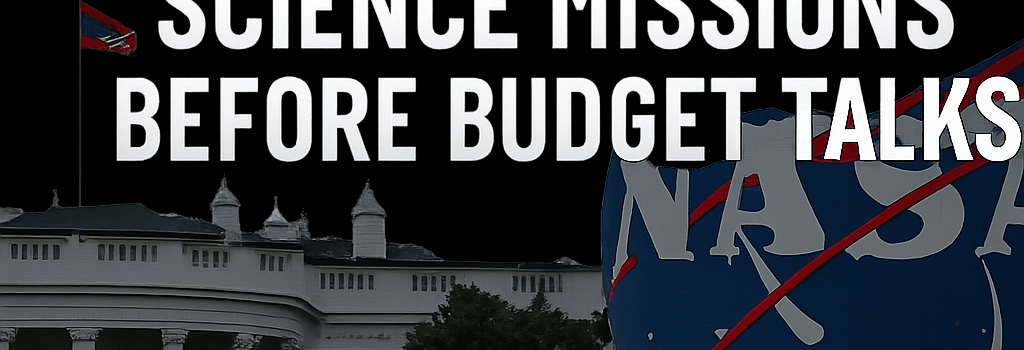White House Grounds NASA Science Missions Before Budget Talks

Updated: August 12, 2025 – As the 2026 fiscal year approaches, NASA mission teams have been asked to prepare detailed shutdown plans, signaling an aggressive push by the Office of Management and Budget (OMB) to curtail science activities before Congress finalizes appropriations.
Background: Budget Battle and OMB Directives
In July 2025, NASA’s senior leadership, acting on behalf of OMB, distributed memos to more than 40 principal investigators (PIs) ordering them to draft “closeout” or end-of-life procedures for active science missions. These directives demand that most plans be submitted by July 9, 2025—a deadline complicated by the July 4 holiday.
“We would be turning off some fabulous missions that are doing extremely well,” said Dr. Jim Green, former head of NASA’s Planetary Science Division.
Scope of Proposed Cuts
The White House’s 2026 budget request seeks a 24% reduction in NASA funding—from $24.8 billion in FY2025 to $18.8 billion—targeting the Science Mission Directorate for nearly 50% cuts. If enacted, 41 of NASA’s 124 active science missions would be canceled outright, with another 17 facing immediate zero funding.
- High-profile at-risk missions: Juno (Jupiter orbiter), Mars Sample Return precursor operations, two Venus Atmospheric Explorers, and the Near-Earth Asteroid Surveyor.
- Extended missions like New Horizons—currently performing Kuiper Belt flybys—and the Chandra X-ray Observatory could see instrument safing and data acquisition halted.
Technical Implications of Immediate Shutdowns
Instrument Safing and Data Integrity: Science payloads such as Juno’s JunoCam (1.1 megapixel CCD with custom radiation-hardened electronics) and New Horizons’ LORRI telescope (20.8 cm aperture, 1024×1024 sensor) require controlled power-down sequences to avoid irreversible damage to detectors and onboard CPUs (radiation-hardened RAD750 processors).
Deep Space Network (DSN) Scheduling: Terminating missions early impacts DSN allocations across three global sites. Abrupt cancellation could leave gaps in antenna time, affecting other missions’ telemetry, tracking, and commanding windows.
Additional Analysis: International and Geopolitical Consequences
Stranded missions not only stall US science but also weaken international partnerships. The European Space Agency’s JUICE mission to Jupiter, collaborating with Juno-derived gravity models, may lose critical complementary data. Meanwhile, China’s CNSA has accelerated its lunar program, recently announcing a new sample-return orbiter set for 2027.
Long-Term Workforce and Innovation Impact
Experts warn that closing missions erases institutional knowledge. Engineers specialized in spacecraft anomaly resolution and instrument calibration will disperse, hampering the ability to revive projects even if funding is restored later. A 2024 NASA audit estimated reconstituting a mothballed mission workforce could take 18–24 months and cost 30% more than uninterrupted operations.
Congressional Response and Latest Developments
On August 5, 2025, the Senate Appropriations Subcommittee approved an amendment restoring $1.2 billion above the White House request for NASA science, including funding protection for Juno’s extended mission and the Mars Sample Return Campaign Office. House and Senate negotiators must resolve differences by September to avoid a stopgap continuing resolution.
NASA Administrator Bill Nelson has publicly challenged the OMB plan, stating, “Grounding these missions undermines decades of investment and cedes leadership in space science to our strategic competitors.” Representative Stephanie Murphy (D-FL) introduced a bipartisan bill requiring OMB to seek congressional certification before terminating any mission above $100 million annual operations cost.
OMB’s Playbook: From PBR to Impoundment
Sources indicate OMB Director Russ Vought is prepared to convert the President’s Budget Request (PBR) into NASA’s default operating plan if no FY2026 budget is enacted by October 1. This aggressive stance includes potential use of rescission and impoundment authorities to withhold appropriated funds, a tactic not seen since the 1970s.
What’s Next?
- Congressional markups in September will determine the fate of science funding levels.
- NASA PIs finalize closeout procedures, including safe mode initiation, data archiving protocols, and hardware turn-off scripts.
- Legal challenges may arise if OMB attempts unilateral impoundments, setting up a showdown over executive authority vs. Congressional appropriations power.
The coming weeks will be critical: mission teams race to preserve years of scientific and engineering progress, while policymakers debate the very role of NASA as a driver of American innovation and leadership in space exploration.